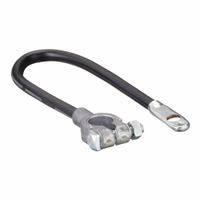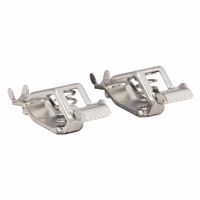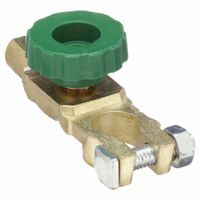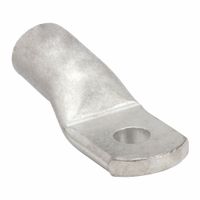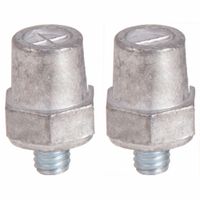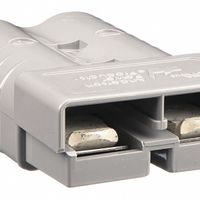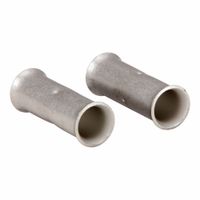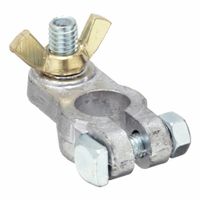Call +(254) 703 030 000 / 751 483 999 / 721 704 777
Battery Connections
Battery terminal connections attach battery posts to stud connectors, and allow a quick disconnection from the battery. These connectors help eliminate current drain during storage. Battery lugs attach to the ends of battery and welding cable so they can be connected to other electrical equipment. B .....Read More
Frequently Asked Questions
What are battery terminal connectors?
Battery terminal connectors are components used to connect a battery to the electrical system of a device or vehicle. They serve as the interface between the battery terminals and the cables that distribute electrical power. Typically made from conductive materials like lead, brass, or copper, these connectors ensure efficient transmission of electricity with minimal resistance.
There are two main types of battery terminal connectors: top post and side post. Top post connectors are the most common and are used in many automotive applications. They clamp onto the battery's protruding posts, which are usually marked with a positive (+) and negative (-) sign. Side post connectors, on the other hand, attach to the side of the battery and are often found in General Motors vehicles.
Battery terminal connectors come in various designs, including bolt-on, clamp-on, and quick-release types. Bolt-on connectors use a bolt to secure the cable to the terminal, providing a strong and stable connection. Clamp-on connectors use a clamping mechanism to hold the cable in place, allowing for easy installation and removal. Quick-release connectors are designed for convenience, enabling fast disconnection and reconnection without tools.
Proper maintenance of battery terminal connectors is crucial for optimal performance. Corrosion, often caused by acid leakage or environmental factors, can impede electrical flow and lead to starting problems or power loss. Regular cleaning with a wire brush and applying a protective coating, such as petroleum jelly or a commercial anti-corrosion spray, can help prevent corrosion.
In summary, battery terminal connectors are essential components that facilitate the flow of electricity from the battery to the electrical system, ensuring reliable power delivery and vehicle operation.
How do quick disconnect battery terminals work?
Quick disconnect battery terminals work by providing a fast and convenient way to connect and disconnect a battery from a vehicle or device without the need for tools. These terminals typically consist of a clamp or lever mechanism that can be easily opened or closed by hand.
The design usually includes a base that attaches to the battery post, either the positive or negative terminal. The quick disconnect mechanism is integrated into this base. When the lever or clamp is engaged, it creates a secure connection between the battery post and the terminal, allowing electrical current to flow. To disconnect, the user simply releases the lever or opens the clamp, breaking the connection and stopping the flow of electricity.
These terminals are often used in situations where batteries need to be frequently removed or replaced, such as in marine applications, RVs, or vehicles that are stored for long periods. They help prevent battery drain and make maintenance tasks easier and faster. Additionally, they can enhance safety by reducing the risk of accidental short circuits during battery handling.
Quick disconnect terminals are available in various designs, including twist-and-lock, lever-operated, and push-button styles, each offering different levels of ease and security. They are typically made from conductive materials like brass or copper to ensure efficient electrical conductivity and are often coated with a protective layer to resist corrosion.
What is the purpose of battery lugs?
Battery lugs serve as critical connectors in electrical systems, specifically designed to facilitate the secure attachment of cables to battery terminals. Their primary purpose is to ensure a reliable and efficient electrical connection between the battery and the electrical system it powers. This connection is crucial for the effective transmission of electrical current, which is necessary for the operation of various devices and systems.
Battery lugs are typically made from conductive materials such as copper or aluminum, which offer excellent electrical conductivity and durability. They are designed to withstand the high current loads that batteries often deliver, ensuring minimal resistance and heat generation at the connection point. This helps in maintaining the efficiency and safety of the electrical system.
The design of battery lugs often includes features such as a crimping or soldering area for secure attachment to the cable, and a hole or slot for bolting onto the battery terminal. This ensures a stable and vibration-resistant connection, which is essential in automotive and industrial applications where movement and environmental factors can affect the integrity of electrical connections.
Additionally, battery lugs are available in various sizes and configurations to accommodate different cable gauges and terminal types, providing versatility in their application. Proper selection and installation of battery lugs are crucial to prevent issues such as voltage drop, overheating, and potential electrical failures, which can lead to system malfunctions or safety hazards.
In summary, battery lugs are essential components that ensure a stable, efficient, and safe connection between a battery and its associated electrical system, supporting the reliable operation of powered devices and systems.
How do you install battery terminal connectors?
1. **Safety First**: Ensure the vehicle is off, and remove the keys. Wear safety gloves and goggles.
2. **Disconnect Old Terminals**: Start with the negative terminal. Use a wrench to loosen the nut and remove the cable. Repeat for the positive terminal.
3. **Clean Battery Posts**: Use a wire brush or battery terminal cleaner to remove corrosion and dirt from the battery posts.
4. **Prepare New Connectors**: If necessary, strip a small section of insulation from the battery cables to expose fresh wire. Ensure the new connectors match the battery post size.
5. **Attach New Connectors**: Slide the exposed wire into the new terminal connector. Tighten the connector's clamp or screw to secure the wire.
6. **Install Connectors on Battery**: Place the positive terminal connector onto the positive battery post and tighten the nut. Repeat for the negative terminal.
7. **Secure and Test**: Ensure both connectors are tight and secure. Start the vehicle to test the connection.
8. **Final Check**: Inspect for any loose connections or corrosion. Re-tighten if necessary.
What are the benefits of using quick disconnect battery terminals?
Quick disconnect battery terminals offer several benefits:
1. **Convenience**: They allow for easy and fast connection and disconnection of the battery without the need for tools, making maintenance and battery replacement more efficient.
2. **Safety**: By enabling quick disconnection, they reduce the risk of electrical shorts and accidental sparks during maintenance, enhancing safety for users.
3. **Time-Saving**: In emergency situations or when frequent battery changes are necessary, quick disconnect terminals save time by simplifying the process.
4. **Versatility**: They are compatible with a wide range of battery types and sizes, making them suitable for various applications, from automotive to marine and industrial uses.
5. **Reduced Wear and Tear**: Frequent screwing and unscrewing of traditional terminals can lead to wear and damage. Quick disconnect terminals minimize this risk, prolonging the life of the battery and connectors.
6. **Improved Connectivity**: They provide a secure and stable connection, reducing the likelihood of loose connections that can lead to power loss or electrical issues.
7. **User-Friendly**: Designed for ease of use, they are ideal for individuals with limited technical skills or physical limitations, allowing them to manage battery connections without assistance.
8. **Corrosion Resistance**: Many quick disconnect terminals are made from materials that resist corrosion, ensuring a longer lifespan and reliable performance in harsh environments.
9. **Cost-Effective**: By reducing maintenance time and the risk of damage, they can lead to cost savings over time, despite a potentially higher initial investment.
10. **Enhanced Mobility**: For applications requiring frequent battery removal, such as in portable devices or equipment, they facilitate easy transport and handling.
How do you prevent current drain during battery storage?
To prevent current drain during battery storage, follow these steps:
1. **Disconnect Devices**: Ensure that the battery is disconnected from any devices or circuits to prevent parasitic drain.
2. **Use a Battery Disconnect Switch**: Install a battery disconnect switch to easily cut off power and prevent any accidental current draw.
3. **Store in a Cool, Dry Place**: Keep the battery in a cool, dry environment to slow down the chemical reactions that can lead to self-discharge.
4. **Charge Before Storage**: Fully charge the battery before storing it. For lithium-ion batteries, store them at around 40-60% charge to minimize stress and prolong lifespan.
5. **Regular Maintenance Charging**: For lead-acid batteries, use a maintenance charger or trickle charger to keep the battery at optimal charge levels without overcharging.
6. **Use a Battery Maintainer**: A battery maintainer can help keep the battery charged without the risk of overcharging, especially for long-term storage.
7. **Remove Corrosion**: Clean the battery terminals and connectors to prevent corrosion, which can cause current leakage.
8. **Check for Leaks**: Inspect the battery for any signs of leakage or damage, which can lead to current drain and reduced performance.
9. **Use Insulating Covers**: Cover the battery terminals with insulating caps to prevent accidental short circuits.
10. **Monitor Battery Health**: Regularly check the battery voltage and health using a multimeter or battery tester to ensure it remains in good condition.
11. **Avoid Extreme Temperatures**: Protect the battery from extreme temperatures, as both high and low temperatures can increase self-discharge rates.
By following these practices, you can effectively minimize current drain and extend the life of your stored batteries.
What materials are best for battery terminal connectors?
The best materials for battery terminal connectors are those that offer excellent electrical conductivity, corrosion resistance, and mechanical strength. The most commonly used materials include:
1. **Copper**: Copper is the most popular choice due to its high electrical conductivity, which ensures efficient power transfer. It is also relatively easy to work with and can be plated with other materials to enhance its properties.
2. **Brass**: An alloy of copper and zinc, brass offers good conductivity and is more resistant to corrosion than pure copper. It is often used in environments where corrosion is a concern.
3. **Lead**: Traditionally used in battery terminals, lead provides good conductivity and is highly resistant to corrosion. However, due to environmental and health concerns, its use is declining.
4. **Tin-Plated Copper**: Tin plating on copper terminals enhances corrosion resistance while maintaining excellent conductivity. This combination is ideal for automotive and marine applications where exposure to moisture is common.
5. **Nickel-Plated Copper**: Nickel plating provides superior corrosion resistance and is often used in harsh environments. It also offers good conductivity and durability.
6. **Stainless Steel**: While not as conductive as copper or brass, stainless steel is highly resistant to corrosion and is used in applications where durability and longevity are prioritized over conductivity.
7. **Aluminum**: Lightweight and cost-effective, aluminum is used in some applications, but it has lower conductivity and is more prone to corrosion compared to copper and its alloys.
In summary, the choice of material depends on the specific requirements of the application, including conductivity needs, environmental conditions, and cost considerations. Copper and its alloys, often with protective plating, are generally preferred for their balance of conductivity and corrosion resistance.
